4 Boxes With Insects Inside Them Clip Art Yellow Fish
On This Page Navigation
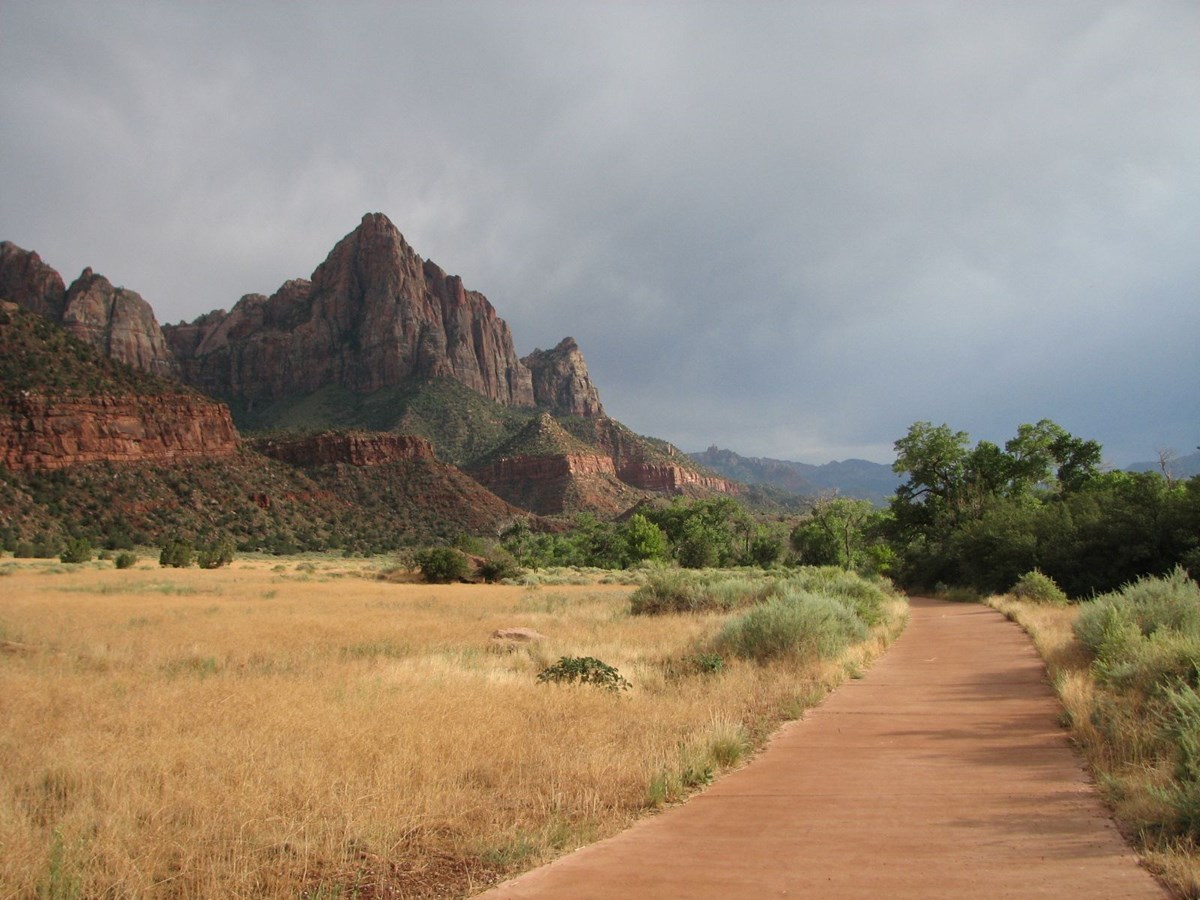
Zion National Park photo
Zion is abode to many insects and arachnids. There are abundant hiding spaces, food sources, and sunny days to bolster the bug population.
Bugs, Beetles, and Others
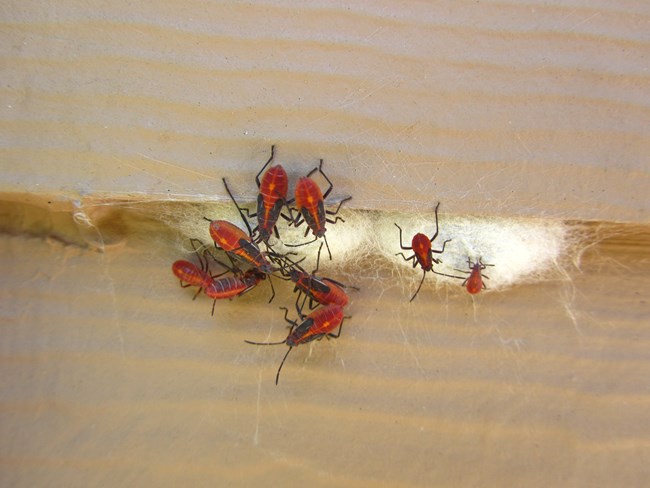
Zion National Park Photo
Box Elderberry Bugs
(Boisea rubrolineatus)
Description: modest blackness and red true bug. Flat, seed shaped torso ~ 1-1.v cm long
Habitat: forested areas of deciduous trees (especially the box elder tree) and buildings when the temperatures drop
Diet: seeds from trees of the maple family unit
Fun Facts: Harmless, though stinky when crushed
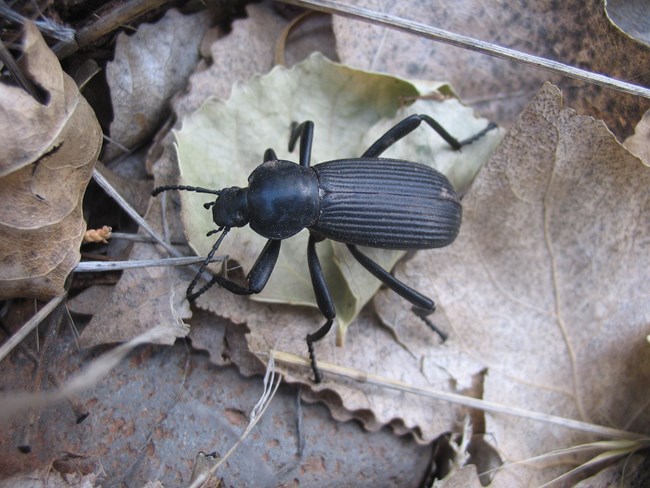
Zion National Park photo
Darkling Beetles
(Eleodes obscurus)
Description: large blackness basis-habitation beetle. Sausage-shaped torso ~5 cm long. Dorsum wing covers may have a ridged appearance
Habitat: all over the park, seen commonly along the Pa'rus Trail
Diet: scavenges on dead and dying plant and animal material
Fun Facts: "Darkling Beetle" is the common name for many similar looking beetles in the park. Stand on their front legs with backside in the air to emit foul smelling odor as a defense force confronting predators
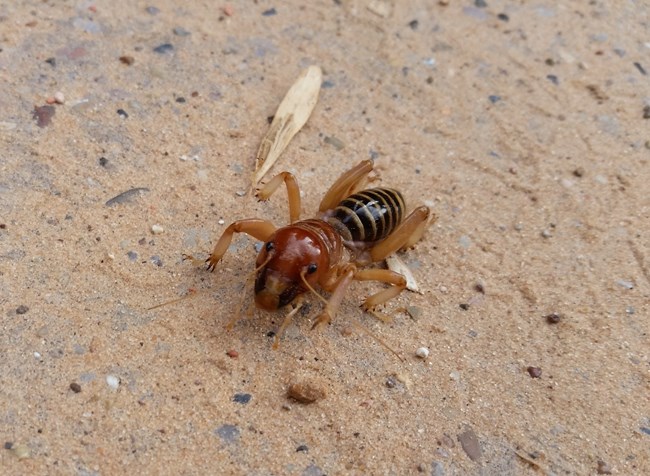
(Stenopelmatus navajo)
Zion National Park Photograph
Jerusalem Cricket
(Stenopelmatus navajo)
Description: Frankenstein-like insect has an pismire shaped head and cricket shaped body. Tan and red in color with striped abdomen up to 6 cm long
Habitat: burrows nether logs or rocks
Diet: decomposing plant and animal affair and other live insects
Fun Facts: Nocturnal insect is sometimes called a potato bug or one-time baldheaded human PAINFUL Seize with teeth
Wasps, Bees, and Ants
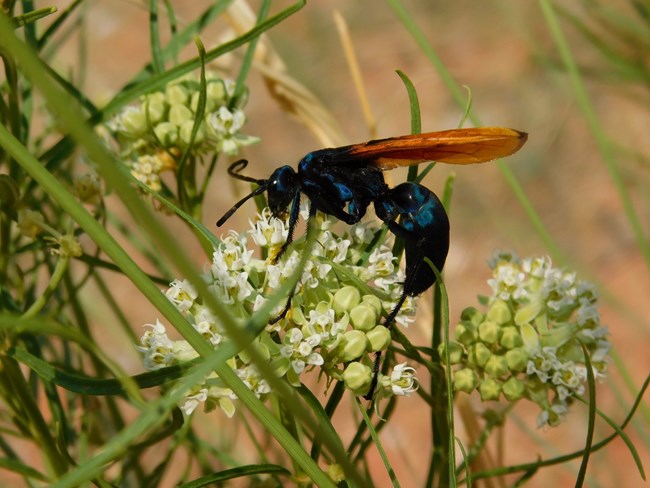
Zion National Park Photograph
Tarantula Hawk
(Pepsis formosa)
Clarification: large black/blueish wasp with vibrant orangish wings. Slender trunk iii-5 cm long
Habitat: widespread throughout park
Diet: fermented nectar, especially from whorled milkweed
Fun Facts: drinking fermented nectar can crusade erratic flight patterns. Female tarantula hawks will sting and paralyze tarantulas, drag them to a burrow, and lay their eggs inside the tarantula. Wasp larvae will consume their way out of the tarantula.
VERY PAINFUL STING
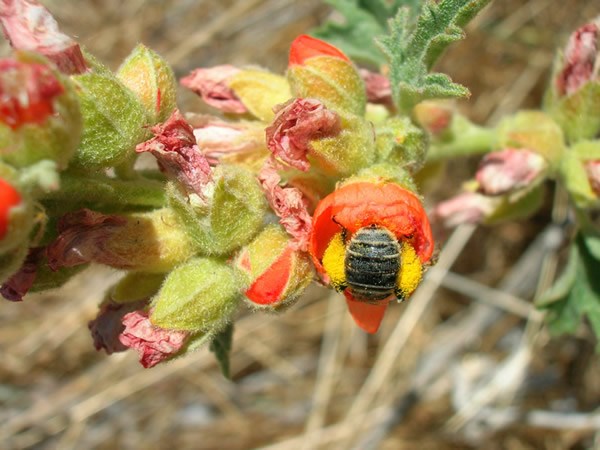
Vince Tependino, ARS Bee Research Lab
Globe Mallow Bee
(Diadasia diminuta)
Description: Small blackness trunk 7 to 9 millimeters long
Habitat: Specialist bee institute in desert scrubland where globe mallow plant is prevalent. Nests are commonly institute in compacted soils
Diet: Adults assemble nectar for nutrient for themselves, assemble pollen from globe mallow plant for offspring
Fun Fact: Also known as a chimney bee, the Globe Mallow bee creates small-scale towers of clay near its nest
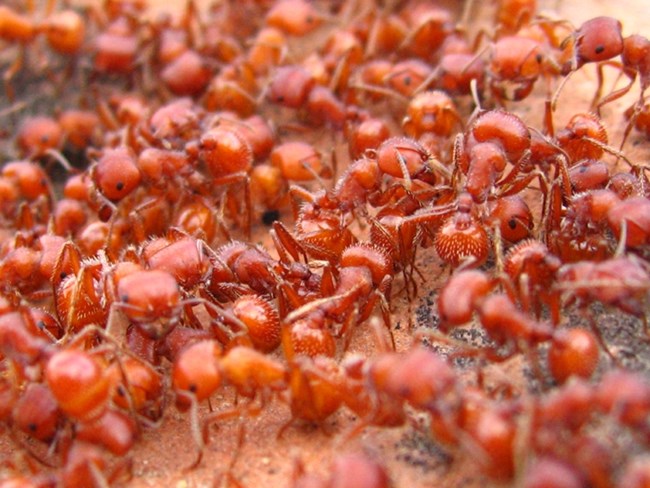
Montezuma Castle National Monument Photograph
Western Harvester Ant
(Pogonomyrmex occidentalis)
Description: large red-brown ant ~ane cm long
Habitat: desert and barren grasslands in mounded nests
Diet: seeds, pollen, or newly expressionless insects
Fun Facts: colonies build large nests with little vegetation surrounding the area. A colony's queen tin can live up to 40 years, but workers only alive upwards to half dozen months. STINGS IF BOTHERED
Butterflies, Dragonflies, and Moths
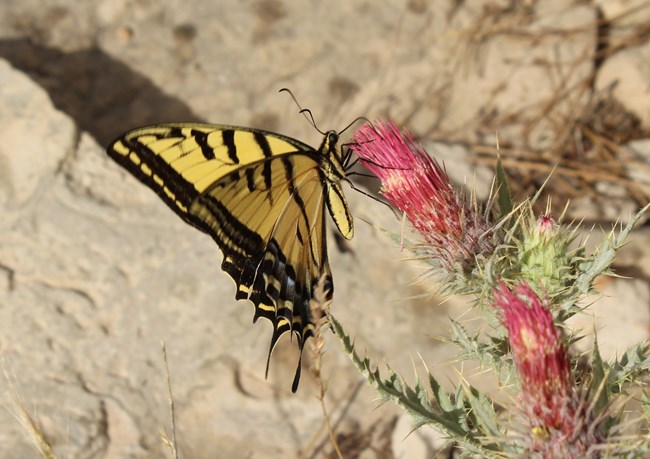
Zion National Park Photo
Swallowtail Butterfly
(Papilio multicaudata)
Description: large yellow and black striped butterfly with wingspan up to 12 cm. Caterpillars are brown and fleshy.
Habitat: near slow-moving h2o sources especially where milkweed is present
Nutrition: caterpillars will eat leaves of host plants, while adults feed on nectar from thistle, milkweed, lilac, etc.
Fun Facts: At that place are two species of swallowtail butterflies in the park, the 2-tailed swallowtail, and the western tiger swallowtail.
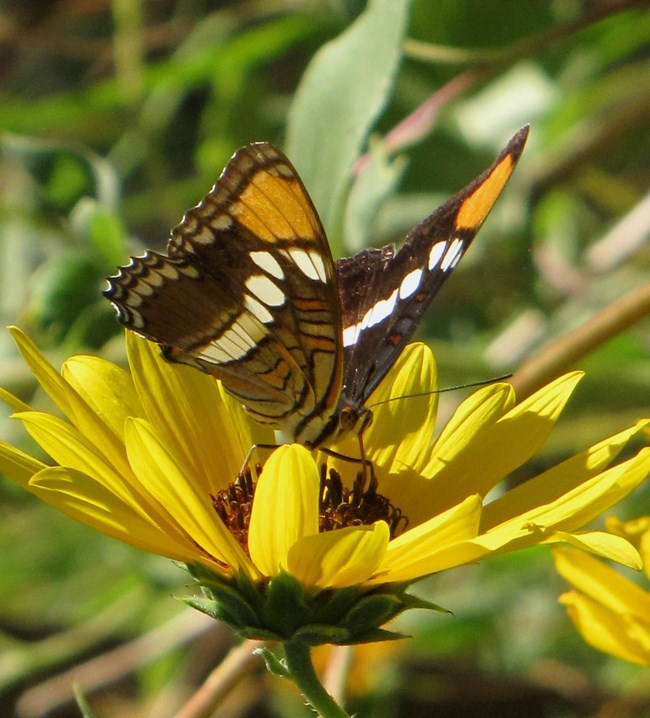
Zion National Park Photo
Arizona Sister
(Adelpha eulalia)
Clarification: by and large black butterfly with orange wing spots and white line on each fly. Wingspan upwardly to 12 cm.
Habitat: Gambel's oak woodlands, riparian canyons
Diet: caterpillars feed on leaves of oak trees while adults swallow rotting fruit, mud, and water
Fun Facts: Looks nearly identical to the California Sister butterfly
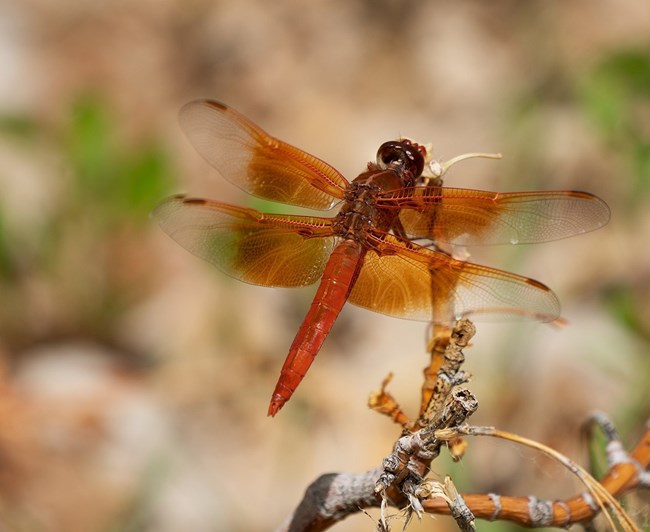
Zion National Park Photo
Flame Skimmer
(Libellula saturate)
Description: adult is large red-orange dragonfly up to 8 cm long. Larvae are large and greenish aureate
Habitat: adults alive in riparian areas, while larvae live underwater in streams and ponds
Diet: adults eat soft bodied insects, while aquatic larvae eat insects and possibly small fish
Fun Facts: Females will lay eggs in streams and ponds by dipping the tip of their abdomen on the surface of the water
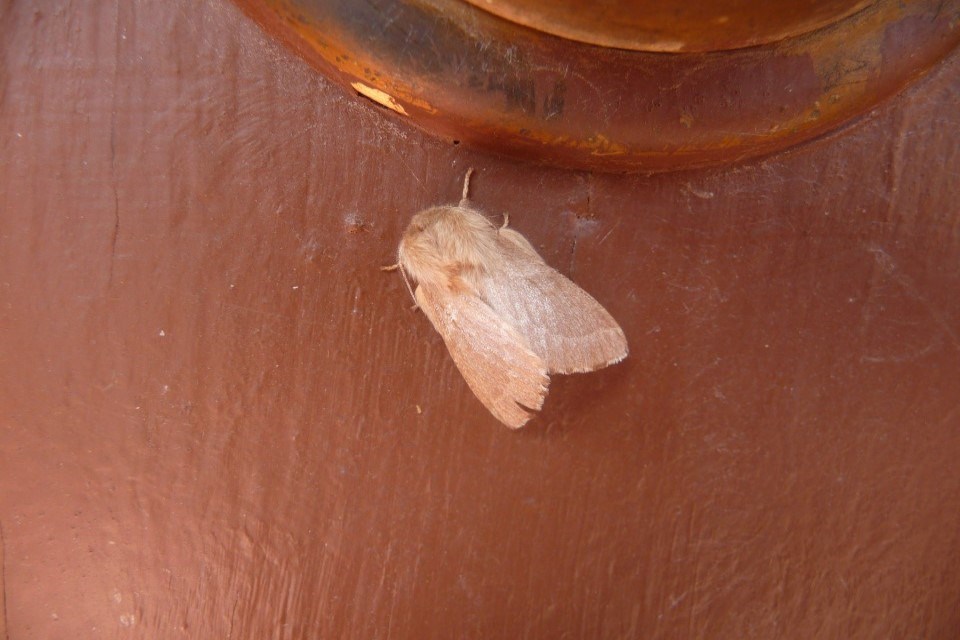
Left image
Southwestern Tent Caterpillar
Credit: Zion National Park Photo
Right image
Southwestern Tent Moth
Credit: Zion National Park Photo
Spiders
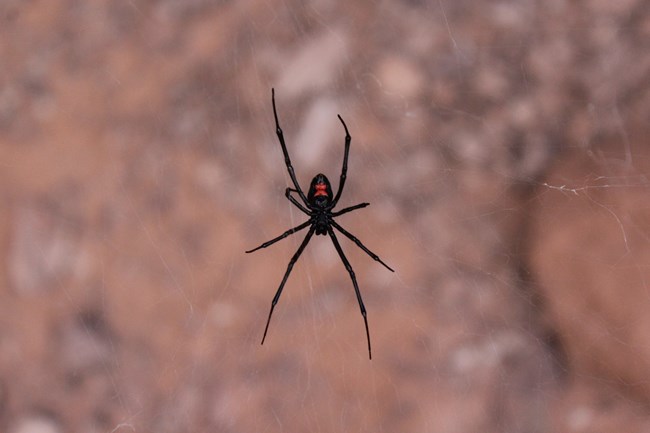
Zion National Park Photo
Black Widow
(Lactrodectus hesperus)
Description: female is a pocket-size blackness spider with a red hourglass shape on bottom of spherical abdomen, less than 2 cm in length. Male person is a slender brown spider with cream colored markings on dorsum of abdomen
Habitat: widespread throughout park, ofttimes in or effectually buildings
Diet: insectivorous web-architect
Fun Facts: female person spiders frequently hang upside down in their webs, waiting for food. Males of Northward American black widow species are not ofttimes killed by females while mating, allowing them to make multiple times during their lives. If injured while mating, the female person black widow can feed on the dead or dying male
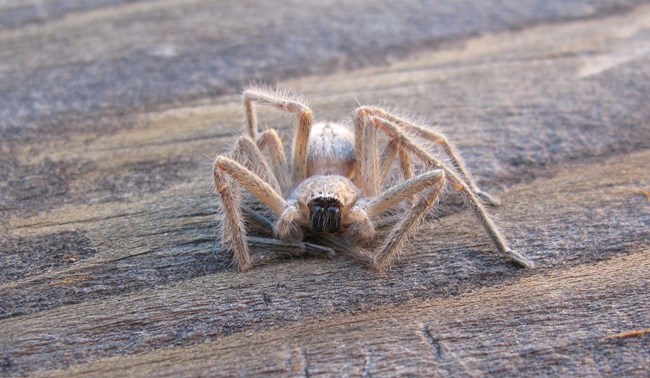
Zion National Park Photo
Golden Huntsman
(Olios fasciculatus)
Description: slender, tan, hairy legged spider with legs up to 5 inches long
Habitat: stone walls, tree trunks, within buildings
Nutrition: hunts insects, merely not a web-building spider
Fun Facts: has no permanent web or dwelling, but wanders around hunting for food. Females behave egg sacs in jaws and young on their backs
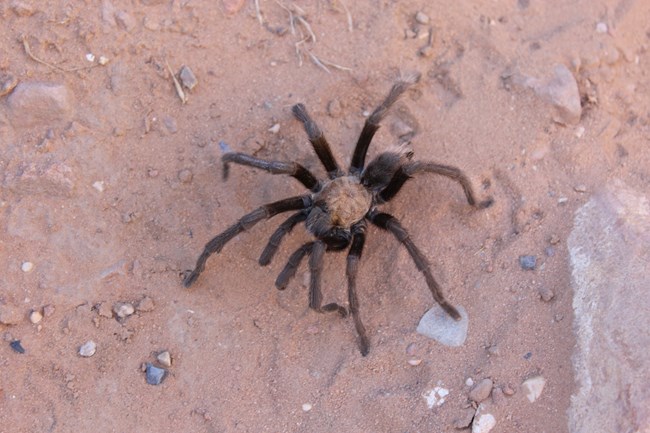
Zion National Park Photo
Desert Tarantula
(Aphonopelma iodius)
Description: big, thick bodied hairy spider, usually tan to nighttime brown in colour
Habitat: open arid country, oftentimes in underground burrows
Diet: opportunistic omnivores, usually consume insects
Fun Facts: While female tarantulas usually stay very close to their burrows, in the tardily summer male tarantulas go on a migration to find receptive females in their homes
Go to our Desert Tarantula page for more in depth information about Zion's Desert Tarantula
Scorpion
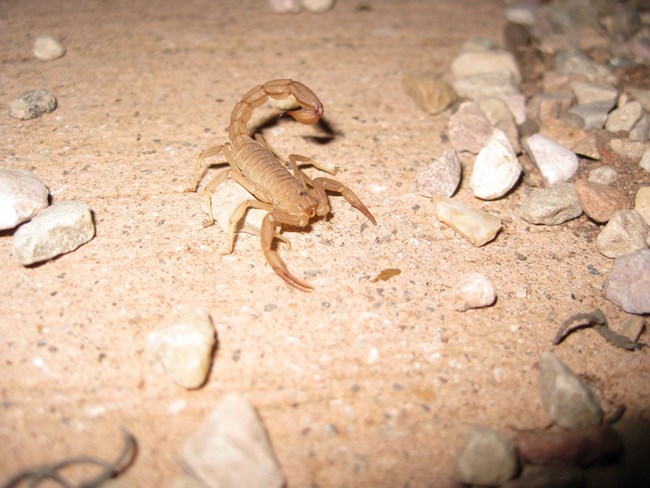
Zion National Park Photo
Giant Desert Hairy Scorpion
(Hadrurus arizonensis)
Description: large scorpion with dark gray torso and tan-gold appendages, upwards to 12 cm long, plus tail
Habitat: washes or low peak valleys in burrows
Nutrition: large insects, small reptiles, amphibians, and mammals
Fun Facts: Nocturnal hunter that fluoresces nether UV light. CAN STING IF BOTHERED
0 Response to "4 Boxes With Insects Inside Them Clip Art Yellow Fish"
Publicar un comentario